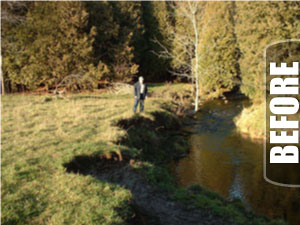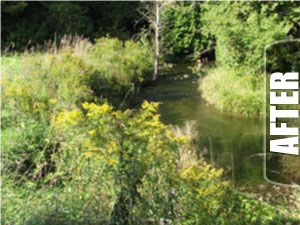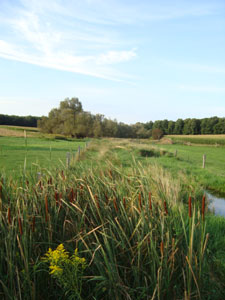ARCHIVE EQUINE NEWS STORIES
| Current news is available at TheHorsePortal.ca, Equine Guelph's online learning platform for practical, quick learning. Given the vast amount of information on horse health and welfare, Equine Guelph has archived its past news articles from 2002-2020. They are listed below, along with a search function available to find specific healthcare topics. | |
Healthy Horses and How To Protect Water ResourcesJune 2011
By Patricia Lowe, Central Lake Ontario Conservation Authority

 If you are fortunate enough to have a creek, wetland or seasonal water course running through your pasture, you likely have already taken steps to fence out your horses, provide an alternative drinking water source and naturalize the ribbon of land along it with native trees and shrubs. By taking action and stewarding your land in this positive way, you are ensuring your horse has a safe clean source of drinking water, limiting the risks associated with walking up and down unstable creek slopes and of course, protecting the natural environment.
If you are fortunate enough to have a creek, wetland or seasonal water course running through your pasture, you likely have already taken steps to fence out your horses, provide an alternative drinking water source and naturalize the ribbon of land along it with native trees and shrubs. By taking action and stewarding your land in this positive way, you are ensuring your horse has a safe clean source of drinking water, limiting the risks associated with walking up and down unstable creek slopes and of course, protecting the natural environment.
The natural vegetation along a creek or waterway contributes to the healthy watershed guidelines targeted by Conservation Authorities across the province. Science tells us that having 75 percent of a streams length naturally vegetated with a 30 metre wide buffer, is ideal for watershed health. If the majority of plant species in this buffer are native, it will attract birds that will consume nuisance insects. In addition to the birds, you will also attract beneficial insects to pollinate yours or your neighbours crops. Some of those insects also provide sustenance for the fish found in your local creek or waterway.
You could stop right there with an impressive list of environmental benefits from stewarding and maintaining a natural buffer on your land, but there is another very important service it provides to watershed health. Horse urine and manure can contain a variety of synthetic and natural medications that horses receive as part of their general health care. These end up in manure piles, pastures and other areas of your farm and are eventually carried by surface water to your local stream or water course. While the research on the effects of those medications on aquatic communities is in the early stages of development, fisheries biologists are reporting significant concerns. Common de-worming medications may pose serious health threats to aquatic species.
 Vegetation buffers along a watercourse provide a natural solution to trapping those contaminants and contributing to improving overall watershed health.
Vegetation buffers along a watercourse provide a natural solution to trapping those contaminants and contributing to improving overall watershed health.
To find out more about stewardship programs available to help you improve the natural buffers around water features on your land, contact your local Conservation Authority. Not sure which of the 36 Conservation Authorities you should contact, check out the provincial map and contact listing on the Conservation Ontario website at www.Conservation-Ontario.on.ca
This article has been prepared by the Healthy Lands for Healthy Horses Steering Committee, which is comprised of representatives from the Ontario Equestrian Federation’s Horse Facilities Council, Uxbridge Horseman’s Association, Ontario Trail Riders Association, Equine Guelph, University of Guelph, Ontario Ministry of Agriculture, Food and Rural Affairs and various Conservation Authorities. Funding for events organized by this committee has been provided by the Ontario Soil and Crop Improvement Association from the Nutrient Management BMP Demonstration Grant funding project.
For more information please visit: www.equineguelph.ca/healthylands.php